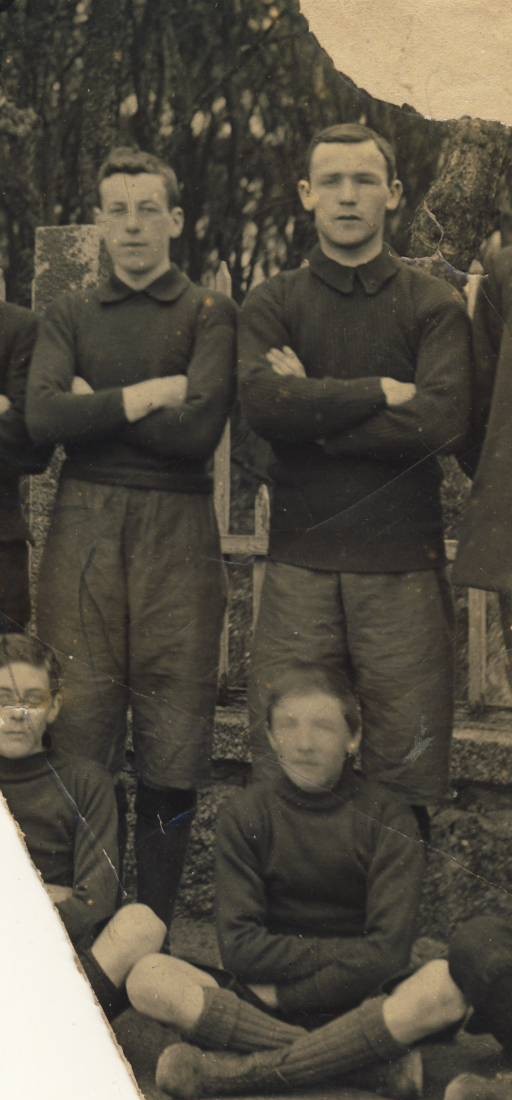
Our earliest picture of Harry (back row, left). This might be a Perth Academy school picture taken in 1900 when he'd be 14.
| The Meigle Wightons |
| Generation 7: Harry Latta Wighton (1886 to 1965) | |
 |
|
|
Our earliest picture of Harry (back row, left). This might be a Perth Academy school picture taken in 1900 when he'd be 14. |
|
| Grandparents | John Baxter Wighton and Catherine Latta | Alexander Hutcheon & Margaret Strachan Burns | ||||
| Parents | John Murray Wighton | Amy Louisa Hutcheon | ||||
| Our Gen.7 Ancestors | Harry (Latta) (b. 1886) | wed (1912) | Miriam Eileen (b. 1890) | |||
| Harry (Latta)'s Siblings | Ella (Burns) (b.1887) | Amy (Louisa) (b.1891) | ||||
| Harry (Latta)'s Children | (Amy) Ella b.1913) | John Latta (b.1915) | James Jackson (b.1916) | Baby Wighton (born and died in 1918) | ||
|
Harry's infancy Harry Latta Wighton was born at 3:45 p.m. on March 22, 1886, at 5 Priory Place, Perth. Harry's father, John Murray Wighton, was working for Scotland's civil service at the time and was engaged by the Scottish Prison Service as a clerk engaged in purchasing supplies for the Perth Prison which was about a half-mile south of the place where they were living. Speaking of John Murray... while searching for some information about Perth's elementary schools in the 1887 on-line copy of the Perth Directory, (the equivalent of a city's telephone directory but without the telephone numbers) I discovered that John Murray had a secret second career, at least he did in 1887. In addition to working for the prison service, he was also working as an insurance agent for the Caledonia Insurance Company. I looked to see if the company was selling a "get out of prison free" policy, but didn't find any such mention. Back to Harry... Harry was named after his uncle (surprisingly named Harry too, or perhaps he's better identified as Harry One who died as an infant in India while Harry's grandfather (John Baxter Wighton) was stationed there. The Latta name came from his paternal grandmother, Catherine Latta, who just happened to be in India at the same time as Harry One was born. Coincidence? I think not. Before moving further into Harry's biography, let's talk about Perth a bit first. If you haven't read about the early history of Perth from our Wighton Family website, you can find that essay here. Also from the same website, you can read an essay on the very early Wighton citizens of Perth by clicking here. When Harry was growing up, Perth's main businesses were in the production of linens, the bleaching of linen, glove making, glass making, insurance and whiskey distilling. Pullar's Dyeworks started in 1824 and by 1852 had become Perth's largest employer and largest dyer in Scotland. It was awarded the Royal Warrant as dyer to Queen Victoria. It later evolved into a dry-cleaning business. Both Dewars and Bells have long histories in Scotland's whisky distilling and both had links to Perth in their early days. General Accident Fire and Life Assurance Company became another household name. It was founded in Perth in 1885 and began to insure motor vehicles in 1896. Speaking of transportation, the first railway station in Perth was built in 1848. Horse-drawn carriages became popular in the 1890s, but after electricity came to the city in 1901, electric trams became more popular. A little further afield, the Firth of Forth railway bridge became operational in 1890. (The word firth means estuary while Forth refers to the River Forth. Thus, Firth of Forth is the estuary of the river Forth.) The railway bridge over the firth was the first ever steel bridge in the UK and it connected Edinburgh with south Fife, and from there it was a jaunt of 40 or 50 miles to get to Perth. I mention this because, in the family's oral history, word had it that Harry worked on that bridge during its construction. This was no mean feat given that he would have been about 4 years old at the time. Obviously, he was destined to be a civil engineer. |
|
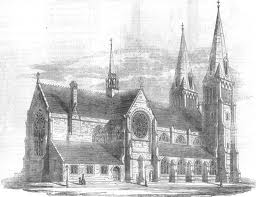 |
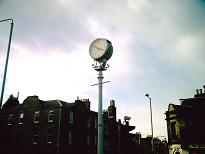 |
| St. Ninian's Cathedral |
Craigie Clock, Priory Place, Perth |
|
The two pictures above have tenuous links to Harry Wighton. On the left is St. Ninian's Cathedral of the Scottish Episcopalian Church. Harry's sister Amy Louisa was christened in this church so we might presume that this was the church that the family walked to each Sunday (18 minutes away). Craigie is a little enclave of Perth just south of the main part of town. Today the area is described as a warren of winding Victorian streets, with some unpretentious period properties and quirky shops. The picture of Craigie Clock provides a partial view of the types of buildings where the John Murray Wighton family would have begun their life together. From that little glimpse, it's fair to say that unpretentious doesn't even begin to describe them; However Victorian is an apt descriptor. I found a microfilmed copy of Leslie's Perth Directory for 1887 on the Internet. The directories of the time were a precursor to our telephone directory. There were pages of ads at the beginning of the directory, followed by various lists of different Perth organizations, as well as other important information for Perth citizens, for example, mail delivery schedules (including to the colonies), harbour and shipping lists, principal farmers in the county, and principal proprietors. The bulk of the publication consisted of a general directory listing everyone in Perth by their last name followed by their occupation and address. (Wighton, John, clerk, 5 Priory Place, Craigie). Or, If you wanted to know who lived at 5 Priory Place but didn't know the surname, there was a street directory as well, although Priory Place wasn't actually in Perth, its lissting was located in the Craigie section. From this part of the directory, we learn that John Wighton, clerk, shared #5 with George Burns, a ship owner. Harry's Education |
|
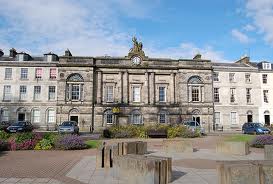 |
|
| The old Perth Academy Building on Rose Terrace |
|
|
From the family's oral history, we are led to believe that Harry attended the Blackfriars Monastery kindergarten on Charlotte Street. The Blackfriars Monastery in Perth was built in 1231. (And you thought that you went to an old school!) If you wish to know which monastery had the most number of ruling monarchs killed inside their building, the Blackfriars Monastery has to rank as #1 in Scotland with King James 1 having suffered that fate in 1437. (As to how that would impact any kindergarten classes, I can imagine desperate monks threatening their charges with a similar fate if they didn't settle down and have their nappy like they should.) While the monastery building is long gone, a plaque at the intersection of Blackfriars and Charlotte streets marks the spot where the murder occurred. Our oral history's brief mention of a Blackfriar's kindergarten suggests that the Blackfriars operated a kindergarten on Charlotte Street and they did so through their monastery. I couldn't find any support for that suggestion. The original monastery building didn't still exist when Harry was of kindergarten age. Google maps reveal that Blackfriars Street is very short, as is Charlotte Street, so a kindergarten operating on that street should have been recorded in the Perth Directory. The Perth Directory revealed a number of businessmen located on those streets, but nothing about a Kindergarten. It's entirely possible that the word kindergarten had a different meaning in the 1890s than how we would use it today. Perhaps it was meant to signify what we would call an elementary school, or as it might be called back then, a grammar school. However, a search through the Perth Directory for school found various public schools and church schools, but none of these were on Blackfriars Street or Charlotte Street and there was no mention of a kindergarten anywhere at all in Perth. Mind you, the directory I used was dated 1887 and Harry wouldn't have started his schooling until about 1891. Harry very likely attended a school of some sort on Charlotte Street; we just can't be sure what it was called. We can say with some certainty though that Harry walked about 20 minutes to get to whatever school it was. For what it's worth, the site of that school was about 8 minutes away from John Murray's presumed work office on Princess Street and both locations were pretty much on a direct line from their home at Priory Place. Now seems like a good time to insert some essays for you to read on Scottish education. The first essay - Education in 18th Century Scotland - was included in a biography of a generation 3 ancestor and you may have perused it already. Next up for your reading pleasure, is an essay on Education in 19th Century Scotland. After you've digested that, you'll be ready to immerse yourself in the third, and last (whew) essay on education. The members of this branch of the Wighton family are predominantly teachers so you can understand, but may not particularly appreciate, our interest in all things educational. The last of the torturous trifecta, (drum roll...) is the history of the school that Harry attended - the Perth Academy. As you've read, Harry's school was actually quite a famous Scottish institution. When Harry attended, it was situated at 7 Rose Terrace which was about a 17 minute walk from Priory Place. During Harry's enrolment, school leaving certificates were awarded at the age of 14 which would have put Harry's departure in 1900. This is confirmed from the 1901 census records which revealed that he was living with his family in Peterhead, Parish of Aberdeen, at the end of March, just after his 15th birthday. So... if the picture of Harry at the top of the page was really a school picture, the latest it could have been taken would have been 1900 and that would make him 14 years old at the time. Looks about right. A final word on Harry's education. W. W. Knox, in Chapter 10 of his A History of the Scottish People had this to say about the disparity of education in Scotland in 1886. Secondary and higher education were still the preserve of the middle and upper classes. The famous high schools of Edinburgh and Glasgow as well as Perth Academy had no working class pupils in 1886. I give this quote to point out that an author writing on the broad topic of the history of Scotland considered Perth Academy to be a famous Scottish secondary school in the same rough time period that Harry would have attended. Pre-emigration Period |
|
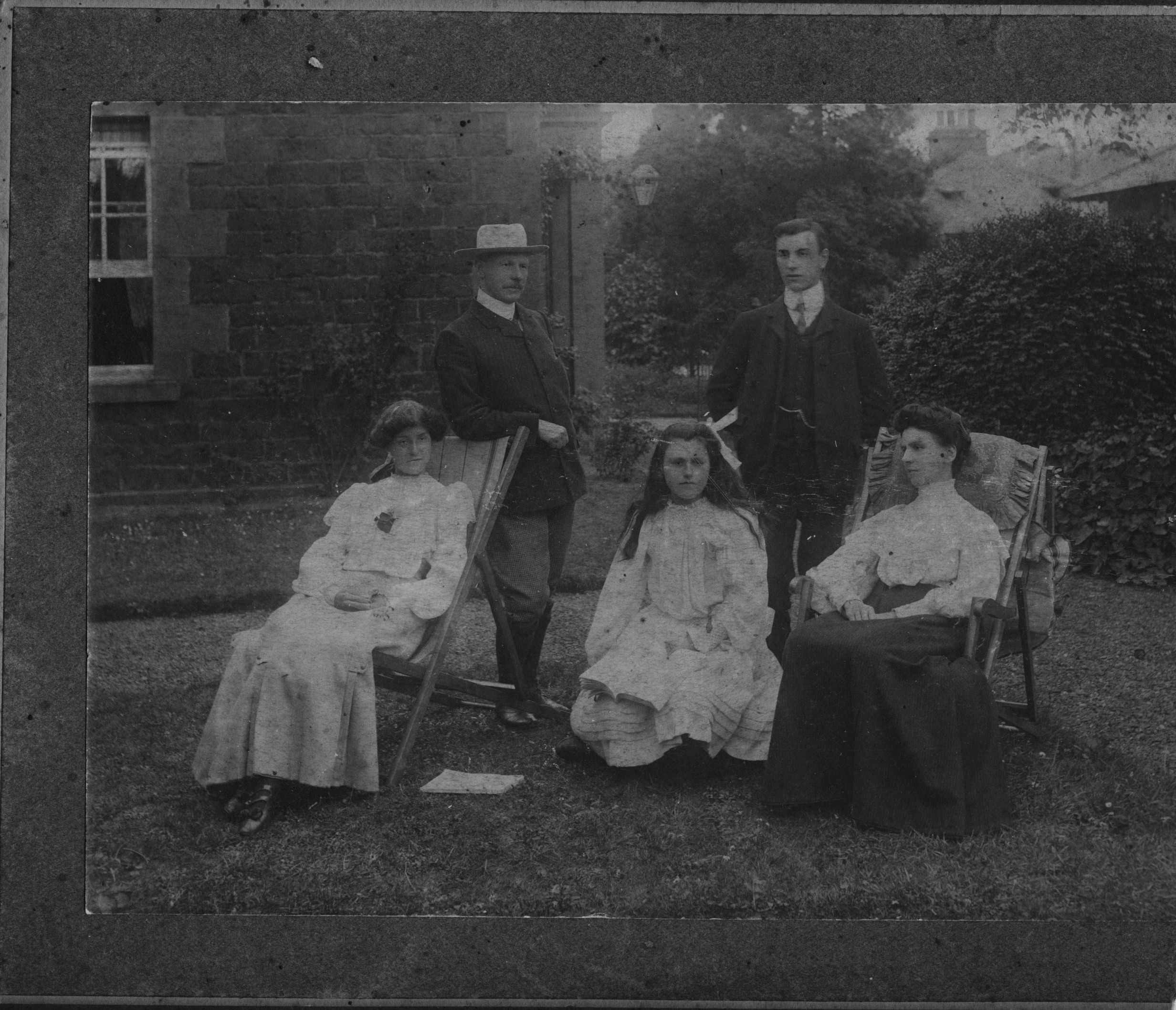 |
|
|
It was difficult to track Harry's life between 1900 when he graduated and 1907 when he emigrated to Canada. (Oops. I may have spoiled the surprise.) We know that he was living with his parents and two sisters in Peterhead in 1901 (census records). His father was working at the Seafield Prison and their accommodations were on the grounds. But, what did Harry do during that 7 year gap? The picture of the John Murray Wighton family above was probably taken about 1906 or 1907 and I expect that it was taken in Milngavie, north of Glasgow and John Murray's third posting. In March 1906, Harry would have been 20 years old and he looks close to that in the picture. If the family had decided to have a family photograph taken just before he left, that would have made him 21 and his youngest sister just under 16. The other thing we know about Harry during this period is that he was the secretary to the Saint Johnstone Football Club in 1906/07 (source: Ella Peterson, neé Wighton). This would put him, at the age of 20, back in Perth. Formed in 1894, St. Johnstone F.C. was Perth's first professional football club. The team name (Saint Johnstone) originated from the ancient name for the city of Perth - Saint John's Toun and St. John's Kirk, a major Perth landmark, was built in that period. The idea of a football team in Perth came from a group of young cricketers who were looking for a winter pastime. The team was formally created in 1885, and in time, team backers and players leased some land on a vacant piece of land in the South Inch where they played their games. This area was later known as the Recreation Grounds. The club was incorporated in 1910 and is known now as the Saints. Much, much later, in 1958 and at the age of 72, Harry gave his grandson David lessons in his back yard on how soccer was really played. So, what was Harry doing from 1901 to 1907 other than being a secretary for a football club? It's time to revisit that snippet of oral history about Harry working on the Firth of Forth Bridge. Ella Peterson would have learned about that work from Harry himself, so it's highly credible. But, how do we reconcile the fact that the bridge was built when Harry was an infant? A little dip into Wikipedia and we find that a permanent maintenance crew had been assigned to care for the bridge after its construction. This crew worked out of a rail yard at Dalmeny Station, the station just before the bridge on the Edinburgh side of the estuary. That crew was large enough that there was a colony of about 50 houses at Dalmeny associated with it. Knowing this, we might now conclude that our oral history was indeed accurate and that Harry did work on the Firth of Forth Bridge, but he worked on its maintenance, not on its construction. One might speculate that it was this work that solidified his desire to become a civil engineer. It's fair to assume that Harry probably put considerable thought into his decision to emigrate from Scotland during this period. But why think about emigrating at all? After all, Harry was part of the new middle class. He had gone to one of the most prestigious schools in Scotland and had graduated at the turn of the century with presumably lots of opportunities. His father had connections, both within the Scottish prison service and through his contacts at the Conservative Club. And Harry would know that having connections in Scotland made a big difference. His grandfather, John Baxter Wighton, had seen that in his army career and had advanced as high as a shoemaker's boy could go, perhaps through some assistance from the nobility that controlled the army. His father had also associated with nobility and gentlemen to the point where he had even been invited to a wedding at one of the most famous palaces in Scotland. John Murray was now, or would soon be, established at what probably was the top of his civil service ladder - Steward First Class. Presumably that same kind of future would be available to a young man who had graduated from a top school and whose father had connections. So ... Why did Harry emigrate? As you've read, there were many reasons for Scots to emigrate in large numbers in the first decade of the 20th century. Four destinations were popular: Australia, Canada, South Africa, and the United States. From Jim Wighton, we know that Harry had considered all but Australia. Obviously, he chose Canada. But, why Canada? I don't know that answer. There were probably numerous reasons and it may have been a difficult choice. I'd like to believe that when that difficult choice came down to the crunch, there may have been one deciding element. Harry's middle name. We've seen before how a middle name can make a difference to a Wighton life. John Baxter Wighton and Catherine Latta named their son, John Murray Wighton in hopes that the middle name would open some doors. It did. In turn, John Murray Wighton and Amy Louisa Hutcheon gave Harry the middle name Latta. Probably, that was just to recognize his paternal grandmother. After all, they followed that same naming protocol by giving Harry's sister the name Ella Burns in recognition of her maternal grandmother. But, perhaps Harry's middle name proved to be more than the end result of a naming ritual. Catherine Latta, after all, was living in Canada when she met her future husband. Perhaps, when Harry came down to a choice between Canada and some other country, the choice was made for a more subjective reason, rather that just analytical assessments of pros and cons. Perhaps Harry chose Canada because of the Latta link. That may be why when Harry pondered what to name his own first son, he ignored what the grandmother naming protocol would have called for (John Hutcheon Wighton) and named him John Latta Wighton instead. Or, perhaps he just liked the name. |
|
|
To Vancouver |
|
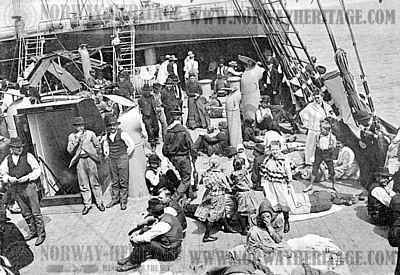 |
|
|
Above, the deck of an emigrant steamship |
|
|
Harry sailed to Canada out of Glasgow on the S.S. Corinthian on April 20, 1907 arriving in Montreal on May 6, 1907. Thanks to cousin Margret who found the ship documents, we know that Harry was travelling as a second class passenger through to Winnipeg and his occupation was described as a clerk. That last snippet of information reveals a little more of his pre-emigration life - he must have worked on the Firth of Forth bridge maintenance crew as a clerk. You can learn more about Harry's ship, the SS Corinthian and his trip to Canada by clicking the link. Arriving in Winnipeg in May 1907, Harry worked for the Canadian Pacific Railway Company as a surveyor before settling in Vancouver (source: James Wighton). Harry kept a record of his monthly salary from 1907 through to 1951 when he retired at the age of 65. That Salary Journal revealed that he began work in June. Now you know why keeping precise financial records would become a behavioural trait of the next three generations of Wighton males. It's in our jeans. The money, that is, and that's where it's staying. Speaking of money, below are Harry's annual incomes while working for the CPR as revealed in his Salary Journal. -----------------------------------
----------------------------------- We don't know where in western Canada he worked as a surveyor, what form that work took, and when he arrived in Vancouver. For more questions, and some answers about what Harry may have been doing, read this essay on the life of a CPR Surveyor. When Harry wasn't on the job for the CPR, what else might he have done? Well, I know that he enjoyed chess. In his Salary Journal, I found a record of an extended chess tournament in 1910 in which he and about 12 other gentlemen played what I expect was a round robin kind of tournament over the 1910/11 year. Harry played 211 games, winning 191 and losing 20. These games pretty much ended after that first year. It's not hard to determine what had caused Harry to give up his life of hanging around with his chums and playing chess. Her name was Miriam. |
|
|
Early Life in Vancouver, 1910 - 1915 |
|
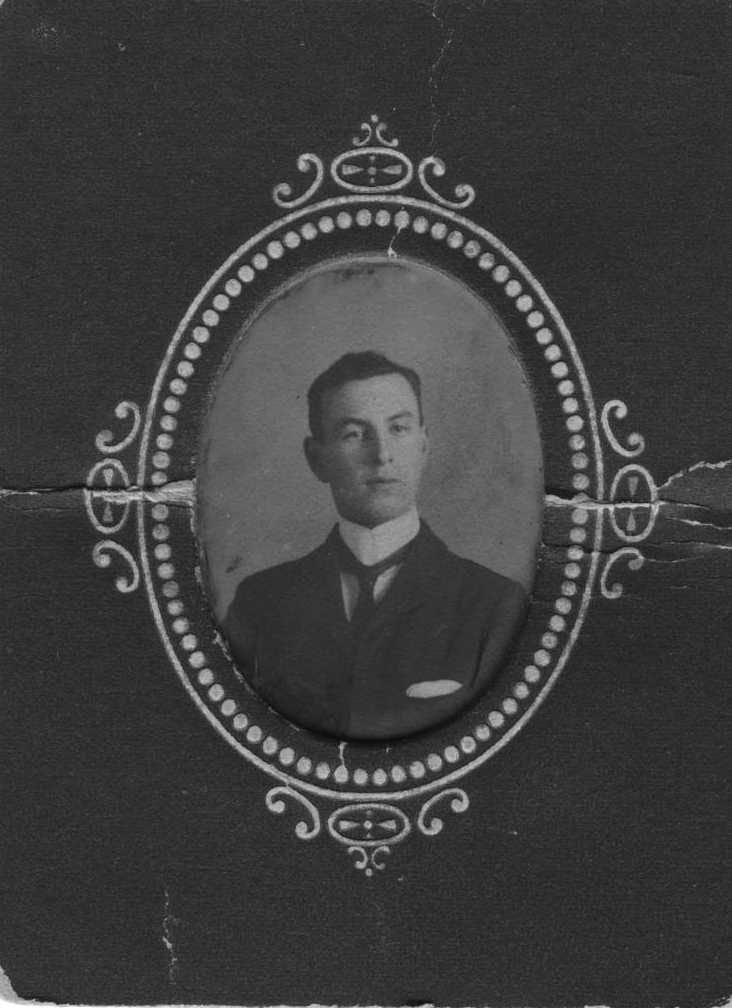 |
|
| Harry Latta Wighton, circa 1910 (?) when he'd be 24. |
|
|
The big event during this 5 year period was, of course, Harry's marriage to Miriam Eileen Jackson on December 23, 1912. They were both residents of Vancouver at the time. Witnesses were Jeanie Murray, presumably a friend of Miriam's, and Thomas Bradbury. I expect that Mr. Bradbury was the husband of Miriam's sister, Bee whose married name was Bradbury and who also was living in Vancouver. Of course, there are always natural consequences when you have to give up a favorite pastime like chess. Amy Ella Wighton was born on October 7, 1913 and John Latta Wighton appeared June 15, 1915. On a work-related front, Harry's annual income during this period was as follows: -----------------------------------
----------------------------------- Note that Harry's income in 1913 was much less than he earned in the other years. His Salary Journal revealed that he had no income whatsoever in April, May, October and November and only a reduced income from June to September. It's possible that these drops in income were associated with Miriam having a difficult first pregnancy (February to October). Or, they might have been because work was not available. We are left to speculate on the cause. However, we don't have to speculate about where the money was coming from. From 1911 to 1915, Harry was employed by the District of South Vancouver. Let me close this chapter of Harry's life with a formal picture that he had taken. It's undated but he looks just a bit older than he was in the small picture shown above. Perhaps taken in 1912? If so, he'd be 26. | |
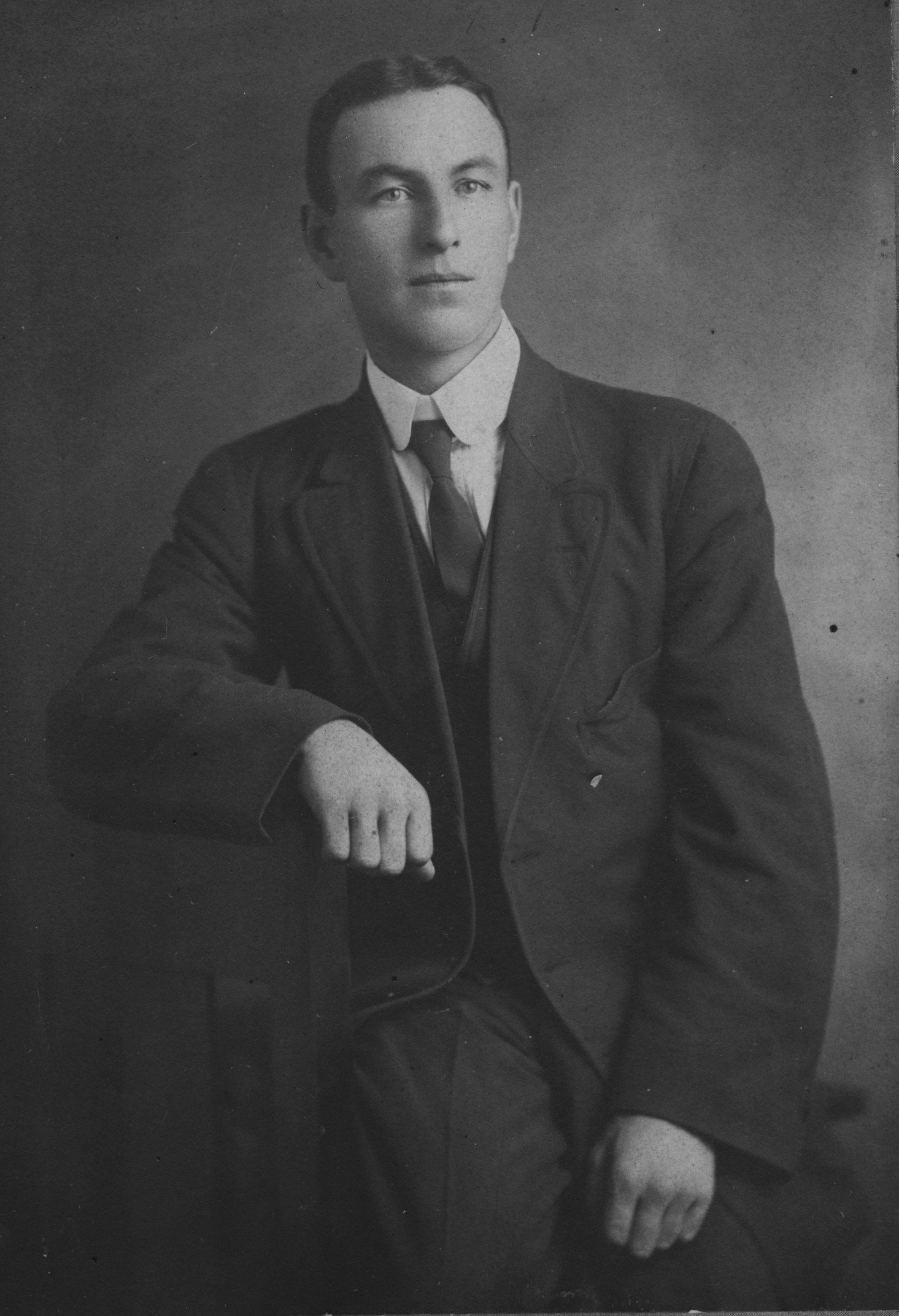 |
|
|
Back to Scotland, 1915-1918 World War I started in July, 1914 and Canada automatically became part of the war when Britain declared herself at war. The target number for Canada's expeditionary force was 50,000 but by 1915, it had reached 150,000 thanks to a wave of patriotism that had swept through the immigrant population. Harry was affected as well and decided sometime in 1915, at the age of 29, to return to Scotland to help with the war effort. He left his job in July 1915, and from a letter from the Canadian Pacific Ocean Services Ltd., we know that Harry left Montreal on August 18, 1915 on the steamship Pretorian. Margaret Serzans established through steamship records that Miriam (age 24), Amy E. Wighton (age 1), and John (age 2 months) were accompanying Harry in 3rd class. They landed on August 29, 1915 in Glasgow and, according to ship documents, were going to be staying at Woodbank, Barlinnie, Glasgow. The Woodbank house was a residence on the grounds of Barlinnie Prison where John Murray Wighton was working and, according to my Internet searches, it served as a place of residence for Barlinnie staff. I assume that John Murray Wighton arranged for Harry and family to stay there temporarily at least. (By 1916, Harry and family would be living at 11 Garnet Terrace, in the Glasgow district of Mount Florida.) In the ship's records, Harry described his employment as an Engineer but listed himself as a Surveyor on his passport that would bring him back to Canada. For interesting information about the ship that the family sailed on, and what life was like on the Atlantic run for both passengers and crew, read the essay on the S.S. Pretorian. From Jim Wighton, we have learned that after Harry arrived in Scotland, he developed an acute case of rheumatism which forced him to leave Glasgow for a more hospitable clime. Harry's Salary Journal shows that he earned no income whatsoever from the time he arrived in Glasgow at the end of August, 1915 to the end of that year. By January, 1916, Harry was earning money again - albeit a paltry amount of 9 pounds per month during January, February and March. This was equivalent to about $45 CAD per month - hardly enough to live on. However, in April 1916, his income shot up to about 23 pounds per month, a much more reasonable amount. (Harry kept his Salary Journal so precisely that he actually had converted his British earnings to Canadian dollars.) We know that Harry worked as a shell inspector during the war, so I have assumed that he was training for that position in the first quarter of the year, and then began full duties in April. I was led to that assumption from some entries in another journal that Harry kept - one that included diagrams of shells and notes on how they were finished. In that journal, he also had what appeared to be study questions (and answers) that might have been part of some classes intended to prepare him for a qualifying exam. For example, do you know how many bullets are contained in an ingot? Or, can you mention in order the different processes in the construction of an 18 pound high explosive shell? Given the big jump in his income, it's clear that Harry knew. Here's something that you may not have known. It's common knowledge that Harry went to Scotland intent on joining the military. What you probably didn't know was that he didn't try to enlist until December, 1916. I had assumed that he'd have done that soon after arriving in 1915, but the rheumatism must have prevented that and he had to spend 1916 recovering while working. From the Classification Certificate that he received from the military, we can see that he had a medical examination on December 20th, 1916. The results of that exam were revealed on January 11, 1917 and Harry was considered fit for service at home only. War in the trenches was not to be. Those readers of the Jim Wighton family owe our presence to Harry's flat feet which caused the army to reject him. His military duties were to be sedentary in nature. You may now join in with the applause from Harry's descendants, and especially from the descendants of Jim Wighton who hadn't been conceived yet, on the benefits of having flat feet in our genetic code. From the Salary Journal, we see a small blip in January of 1917 (very little earned) and then a gnerally regular pattern of healthy income from that point on. I assume that Harry continued in his work as a shell inspector, but this time with the blessings of the military. Those blessing would come in handy when Harry wanted to return home. Here's Harry's income for the war years: -----------------------------------
----------------------------------- Since Harry converted his UK salary to Canadian dollars, we're able to determine that his best shell inspector monthly salaries were far above what he had earned with South Vancouver. Why was he earning so much? This question, plus my curiosity to learn more about what Harry was doing in the Great War, prompted some research into Glasgow's munitions industry. We now know that Harry entered the munitions industry at a time of labour unrest. How much that affected his own life is hard to know. He certainly would have seen the working conditions - not only the long hours, but the factory conditions as well. When he and his family arrived in August 1915, Glasgow would have been buzzing about the rent strikes and they would have been there for the most volatile part of that protest. The illegal strike and the imprisonment of the shop stewards in March 1916 occurred just as Harry was trying to qualify for a position in the industry. Although 1916 was a particularly troubling time in Glasgow, the year ended on a bright note - at least for some of us. James Jackson Wighton was born on December 31, 1916 at 1:20 in the morning at 122 Cumming Drive as reported on his birth certificate. However, the family residence at the time was still at Garnet Terrace. By 1918, pressures were building within the Harry Wighton family. Miriam had been unhappy about coming to Scotland from the very beginning. Now, after well over 2 years in Glasgow, she must have been increasingly unhappy. For one thing, she and her in-laws were not getting along. Plus, by summer, she was pregnant with their fourth child. I expect that her unhappiness was increased by having to raise a young family in what was for her, an Irish woman, a foreign country during the difficulties of war time. Now, a forth child was due before the end of the year. At the time, there were no signs that the war would be over by then. In July/August, the allies' hundred days offensive had begun but no conclusive gains had been achieved yet. The Battle of Amiens and the Battle of the Somme were won in August, but even then, to the general public, this only meant that the allies were recovering ground gained by the Germans in their spring offensive. I doubt that the family was coming back to Canada in expectation that the war would be over soon. I suspect that they were returning because of Miriam's pressure. Later, in his life, Harry would tell his children that he had left Canada to return to Scotland, in part, because he thought that the BC school system didn't measure up. He wanted his children to have the same quality of education that he had had in Perth Academy and I expect that he had intended to remain in Scotland for that purpose. By summer, 1918, transportation back to North America had become possible because the US had entered the war and troop transports were arriving regularly (and returning regularly). With pressure from Miriam, Harry must have reluctantly agreed to return to Canada. Harry and Miriam applied for passports on September 2, 1918. Harry's British passport described him as 5 feet, 6.5 inches tall, with a medium forehead, gray eyes, straight nose, medium mouth, round chin, dark brown hair, dark complexion, and oval face. You can check the accuracy of this description in the passport photo below. I expect that they had applied for the passports after having first received the necessary permissions to travel by military transport. Harry's work with the Ministry of Munitions had qualified him for that treatment. Their itinerary involved travelling on a troop ship that traveled first to New York, and from there to Canada. In his Declaration of an Alien about to Depart for the United States, Harry described himself as a Surveyor, and admitted to having visited the United States previously, specifically a trip to Sumas City in Washington in 1910 for pleasure. Details of their departure (from where, when, and by what ship) were not released ahead of time due to wartime regulations. We have the letter Miriam received, marked secret and confidential from the Government of Canada's Department of Immigration and Colonization. It informed her that a steamship would be sailing for a certain American port from a certain port here in the next few days and then informed her that she would have to go to a Canadian consulate office to get the necessary details. From James Wighton, we know that they left Glasgow for London on October 2nd, arrived in London on October 3rd, left that same day for Southampton, and then left Southampton October 4th to arrive in New York on October 12, and then Montreal one day later. They left Montreal by train on October 13 and arrived in Vancouver on the 18th. In all, the trip from Glasgow to Vancouver took 16 days. The family travelled from Southampton to New York on the White Star Line's Olympic, a sister ship to the Titanic. Notes from James Wighton suggest that the Olympic may have been accompanied by HMS Walrus or Sheldrake for the sake of protection from German subs. The Olympic was one of the largest ocean liners in the world at that time. During 1916 and 1917, she had been chartered by the Canadian government to transport troops from Canada to Britain, and in 1918, she had been serving as a similar role for the US. Her trip from Southampton was also intended to convey US and Canadian troops back to the US as made clear when Miriam's secret and confidential letter made reference to wives and dependents of Canadian officers and soldiers. They didn't know at the time that they were travelling during the Autumn wave of the Spanish influenza - the months during the pandemic when it would be at its most virulent. Harry and his family took up residence in Vancouver at 1374 Laurier Avenue, just north of King Edward (the road he supervised being built) and east of Granville. Our first official post-war sighting of the family was when Harry and Miriam's fourth child died on November 14, 1918. The official death record refers to her as Baby Wighton but it does not give a cause of death. From family history, we know that she died from the Spanish Influenza pandemic that ravaged the world from January 1918 to December 1920. She would have been named Eileen (after Miriam's middle name). |
|
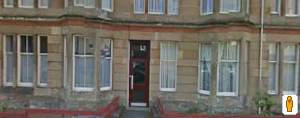 |
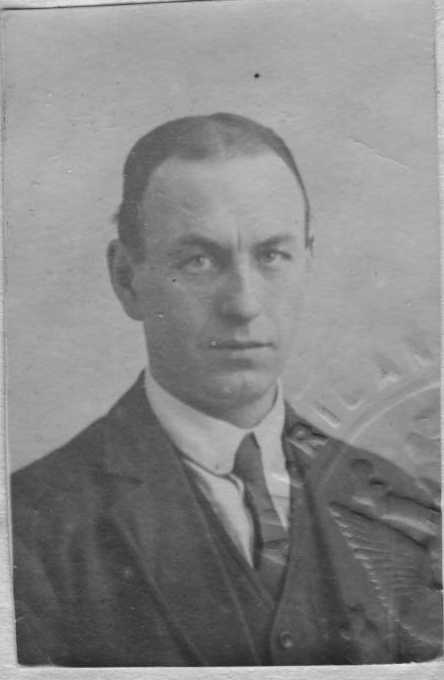 |
| 122 Cumming Drive where James Wighton's birth certificate says he was born. I've highlighted in yellow the plaque that the government placed to commemorate the historic event. |
Harry Wighton's passport photo in 1918 when he was 32 |
|
Life in Vancouver up to the Depression We have very little information on Harry's life in this and ensuing decades. Our best resource is his Salary Journal. From this we can see that at the beginning of 1919 he was working for a firm identified simply as Coughlan and that he was making pretty good money for the time. As a baseline, his earnings in 1914 from South Vancouver were $1076 or $90 per month; In 1919, from Coughlan, he earned $1239 annually or $103 per month. It is possible that he started working for Coughlan in the last months of 1918 but there was no such annotation in his book. We know for sure that he was working for Coughlan in January 1919 and he continued with them through to the middle of April, 1920. A little internet research revealed that Harry's cryptic entry in his Salary Journal referred to J. Coughlan and Sons Shipyard which was located in False Creek, Vancouver. Well, it's hard to expect a shipyard to need a road constructed, and it's doubtful that they'd need a shell inspector, so what was he doing for them and how did he get the job? Good questions. I can give you one possible answer, but you'll need to read the essay on J. Coughlan and Sons Shipyard to get that. It was during the early 20s that Harry took courses (some of them by correspondence) to become a Civil Engineer (source: James Wighton). We have his framed Certificate of Registration which shows that he was enrolled in the Association of Professional Engineers of the Province of British Columbia as a Municipal Engineer and was entitled to use the title Professional Engineer. The date of his enrollment in the association was February, 1921 and I expect that his studies took at least several years. During that time, he continued to hold down a full time job. Back to Harry's Salary Journal. From April 1920 to July 1927, Harry worked on a number of different civil engineering projects for a number of different employers. Sometimes, he'd work for a long period with one employer; other times, his employment would be project-specific. Most of this work was superintending road and/or sidewalk construction. For full details, read the report Harry's Civil Engineering Career. The account of Harry's civil engineering career raised an interesting question. Why did he leave his work as a civil engineer in the middle of 1927 to work for the BC Electric Railway Company as a meter reader? We might also wonder how Harry was able to support his family from May 1924 to March 1925 when he wasn't bringing in any income. An unusual photograph and Harry's Work Journal gives us a good starting point to learn more about what I'll call Harry's sabbatical. Harry's Life after the Depression The world depression hit Harry and his family hard just as it did with every family. There was one saving grace that stemmed from all the crises revolving around the trip to Scotland and the loss of his professional certification. Namely, the depression's effect on the Wighton household could have been a lot worse. For example, had Harry remained in Scotland after the war, he would have found the economic climate in the country very severe. Scotland had its own post war depression that actually started in 1922 when Scotland's heavy industry collapsed and skilled tradesmen could find no work. The country entered a downward spiral of poor health, bad housing, mass unemployment and a widespread sense of despair. Emigration increased dramatically during this time. Scotland never did really recover until the discovery of oil in the North Sea in the 60s. At least, Harry had his family in a new country where the mood was one of optimism and the economy buoyed by the prospects of growth. A second saving grace, if you like, was that Harry's job was never threatened by the Canadian depression. Electricity was necessary for businesses and households to survive, and the BCER needed meter readers. He may not have been earning very much, but during the depression, earning anything was a saving grace. As the 30s passed, Harry's three children graduated from High School and the two sons went on to study at UBC. I expect it was around this time that the family changed residences from Gladstone Street (reasonably close to John Oliver Secondary School) to 4453 W. 8th where they would remain for the rest of their lives. This change put them within walking distance of UBC and I suspect it was chosen for that reason. Harry once owned a car in the early 20s, but after his change of employment, the family never again could afford the luxury of a vehicle. Harry got around by bus with his BCER bus pass. Miriam walked or used the bus to go down town. The boys had bicycles. Family life continued to evolve. Ella went to business school, got married, and had a daughter. John graduated from UBC and entered the teaching profession with his first job as a principal of a small school in the interior of BC. James graduated from UBC, embarked on a Masters Program, and married. When the second world war began, James joined the Canadian forces and was posted to Ottawa where he worked on the development of radar. All three of Harry's children emerged from the war unscathed. After James returned to Vancouver to work for the CBC, bringing two children back home with another to appear soon, Harry would visit them in Lulu Island every other Saturday. He'd also see Ella's daughter on an irregular basis. Marilynne remembers what Harry ate for lunch year in and year out. 1 slice of bologna between two pieces of bread, no lettuce or condiment. She figures that they must have barely made ends meet in the 40s. To say that Harry led a frugal life would be an understatement. All three of his children followed the same pattern and that's no baloney. |
|
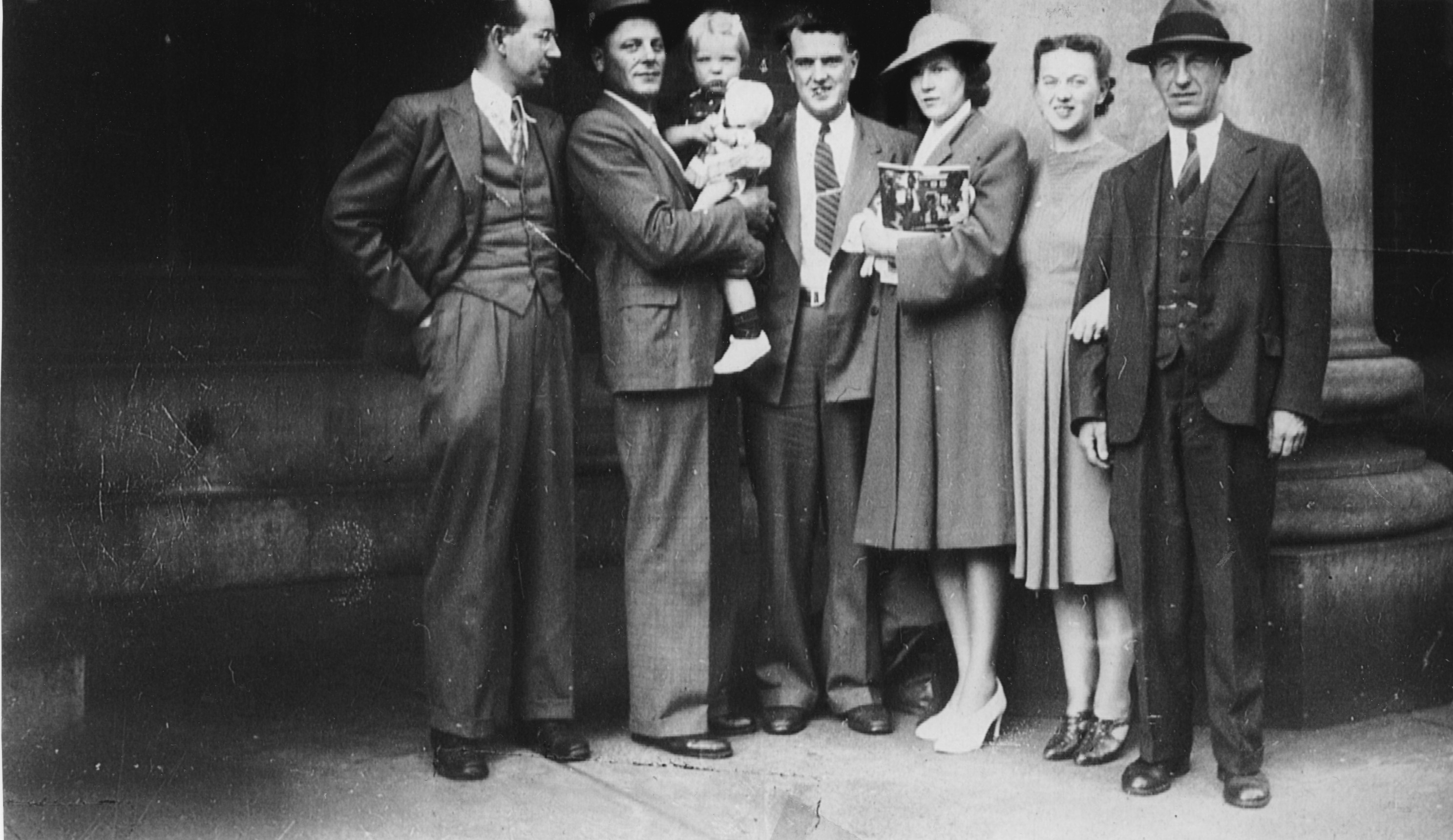 |
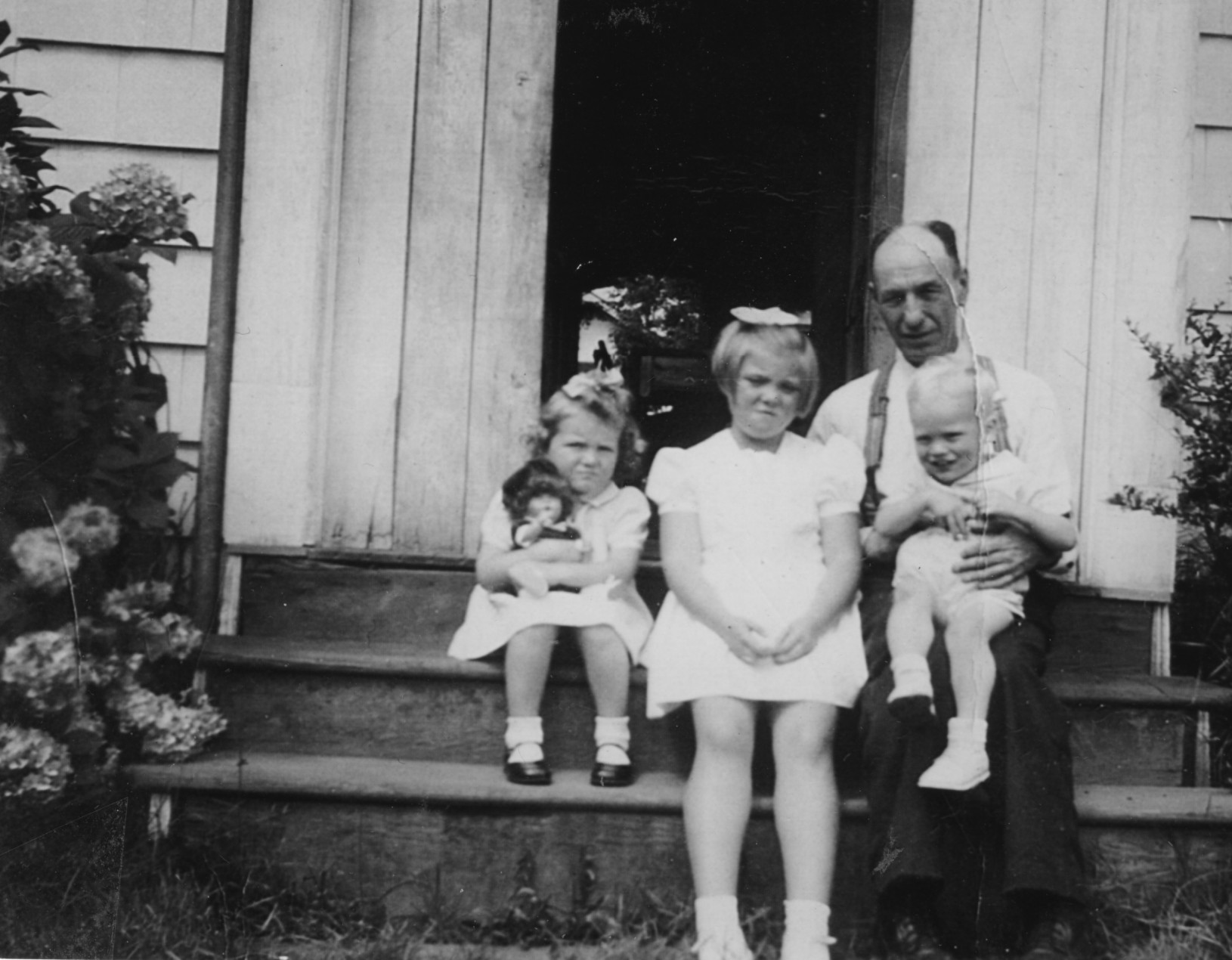 |
| Seeing Jim and Vera off to Ottawa in 1942. John, Otto (Peterson), Marilyn, Jim, Vera, Ella, and Harry. |
Harry with 3 of his 4 grandchildren in 1946. Mary, Marilynne, and David. |
| Retirement |
|
|
There were a number of visits between the Harry's family and Amy Louisa's family in Boston. Thanks to cousin Margaret for providing most of the background. The first visit occurred in 1946 when James, Vera, and Mary went down to Boston from Ottawa to attend Florence Trefry's funeral. (Amy Louisa had two children - Florence, born in 1920 and Ian born in 1921.) Florence died Feb. 14, 1944 very tragically. She was 7 months pregnant and living at home with her parents (Amy Louisa Trefry and Harold Trefry) in Newton, MA while her husband was in the Navy serving in the Philippines during the war. She was washing her hair and suffered a ruptured aorta at the age of 24. Both she and the baby boy succumbed. Harry, Miriam, James, and Vera visited the Trefry family in 1957. The following year, there was another visit to Boston, this time including the whole fam-damily. Harry and Miriam were visiting James and his family in Montreal and we all trooped down to Boston to visit these mysterious cousins we had heard about. Margaret was in Grade 7 and talked with me about hockey which must have made an impression on me because we have continued to correspond since. A girl who knew something about hockey - who would have thought. Dianne would have been 8, as was Dibby, so they hung around. I remember Mary, Dianne, Margaret and Dibby spending a lot of time together in a bedroom doing girls' work (talking). I was given boys' work, which I believe was chopping down trees and ploughing the back 40 with a hand shovel. Jack was around 3 or 4 and so couldn't help. My memory may be a little hazy on this. |
|
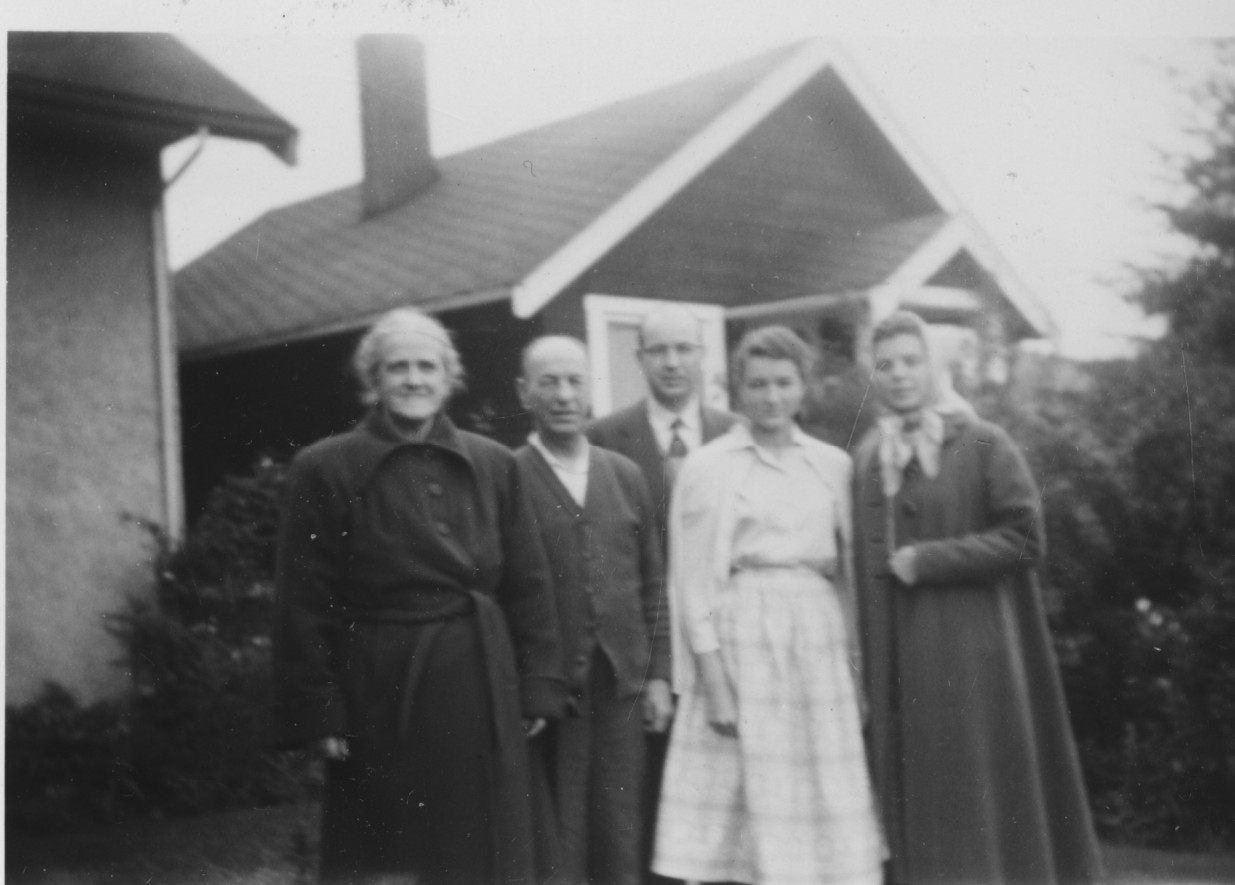 |
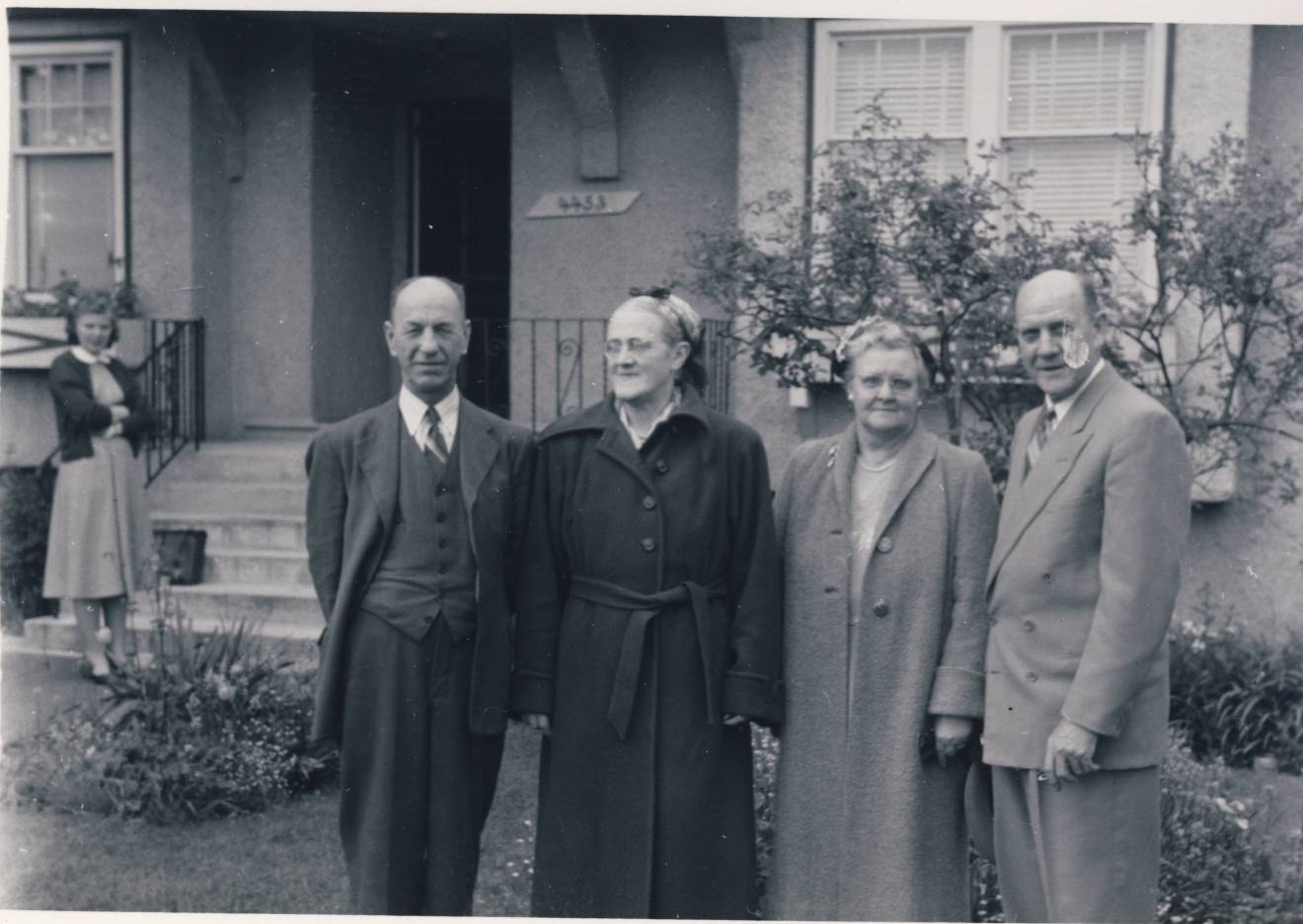 |
| Group picture in 1957: Miriam, Harry, John, Mary, and Marilynne. |
Wighton and Bayley couples near their 50th wedding anniversaries. Marilyn, Harry & Miriam, Susannah (Susie) and Wilfred Bayley. |
|
Facts and figures are all well in good in a biography, and we can get a sense of Harry's life from them. But, what about the man himself? Members of Generation 9 knew Harry. We have memories of him from our childhood and our teen years. What can we tell future generations about the man himself and what he was like? Marilyn, for example, has recounted her observation that Harry always had the same lunch, every day, over and over again, and how he never seemed to mind that it was just bare bread and a slice of bologna. Mary remembers accumulating a most wonderful collection of classics...Little Women comes to mind... all given as presents from Grandpa. By the time I reached my teens, I had quite a little library. Grandpa was a gentle man. I never saw him lose his temper. And yes, I remember him coming to visit every second Saturday. Often one of us would be on his knee either reading him a story or listening to him read. Education was very important to him. My strongest memory of my grandfather was when he played soccer with me for what seemed like hours in the back yard of our home in Montreal and I was lucky to even touch the ball when he wanted to keep it away from me. I'd be running around like crazy, and he'd just shuffle his feet a bit and the ball would be somewhere else. He was in his 70s by this time and I remember that afternoon vividly, in part because he was part of a conspiracy to keep me out of the house while Mom and Grandma made my birthday cake. I remember that afternoon as a special birthday gift from my grandfather. Dianne remembers how Harry would stop a certain young girl from doing something that she shouldn't without uttering a single word. He'd look at her, purse his lips tight, and then just shake his head No. Our Uncle John had the exact same mannerism although we'll have to take Dianne's word for it. Personally, I never did anything wrong so I never got "the look." Actually, that's a lie. I remember quite clearly sitting on Harry's knee when I was perhaps 3 or 4? As I mentioned earlier, Grandpa Wighton came out to our home on Lulu Island every other Saturday and Mom would make a special lunch of beef stew. When it was time for him to go, we kids would be called together to say goodbye, and we'd sit on his lap. One Saturday, I had Grandpa's lap all to myself, and we were sort of wrestling together and I looked up and grabbed his nose and tugged. Then, I observed quite accurately as I recall ... Grandpa, you have a big nose. Mom, who was hovering in the background immediately said David! and would have gone further but Harry must have given her "the look" because she stopped and then Grandpa and I played "grab each other's nose" for a while. Here's an excerpt from a September 26th letter that Harry sent to his daughter-in-law Vera who was in Ottawa recuperating after the birth of her second child (yours truly). Jim would have sent the Vancouver relatives a telegram with the announcement. Harry's reply to this news shows a side to him that I don't think we grandchildren got to see very often. I expect that shortly after you receive this letter that you will be back home again. I expect that Mary will be glad to have you back again. I expect that will go for Jim also. To help you to bring [the boy] up in the right way, I am enclosing a couple of bucks so that you can buy him a bottle of "Usqueboh" in other words "Hooch" or "Firewater." There are several ways to administer this so as to make sure that the boy will benefit, and grow big and strong and be a credit to his parents. You can hit him on the noggin, give him some to drink, but what usually happens is his dad drinks the nasty stuff. Perhaps this sounds pretty bad to a young mother, but I've never heard of the first two methods being used, but I have seen the third idea carried out. However, buy whatever you wish the boy to have, and the best of luck, and I hope you will be all right and around again. I guess this letter sounds sort of screwy ... John Wighton also wrote similar fanciful letters and Jim Wighton frequently used the phrase "sounds all screwy" from time to time. In case you were wondering, Usqueboh is the gaelic term for Scotch whiskey. The gaelic word translates to water of life and was pronounced as usky which became whiskey in English. Just so you know ... Harry's reference to buying some whiskey was completely theoretical. I don't recall seeing any liquor in his house. Harry died in August 7, 1965 at the age of 79. He was buried in Mountain View Cemetery, Vancouver on August 11, 1965. |
|
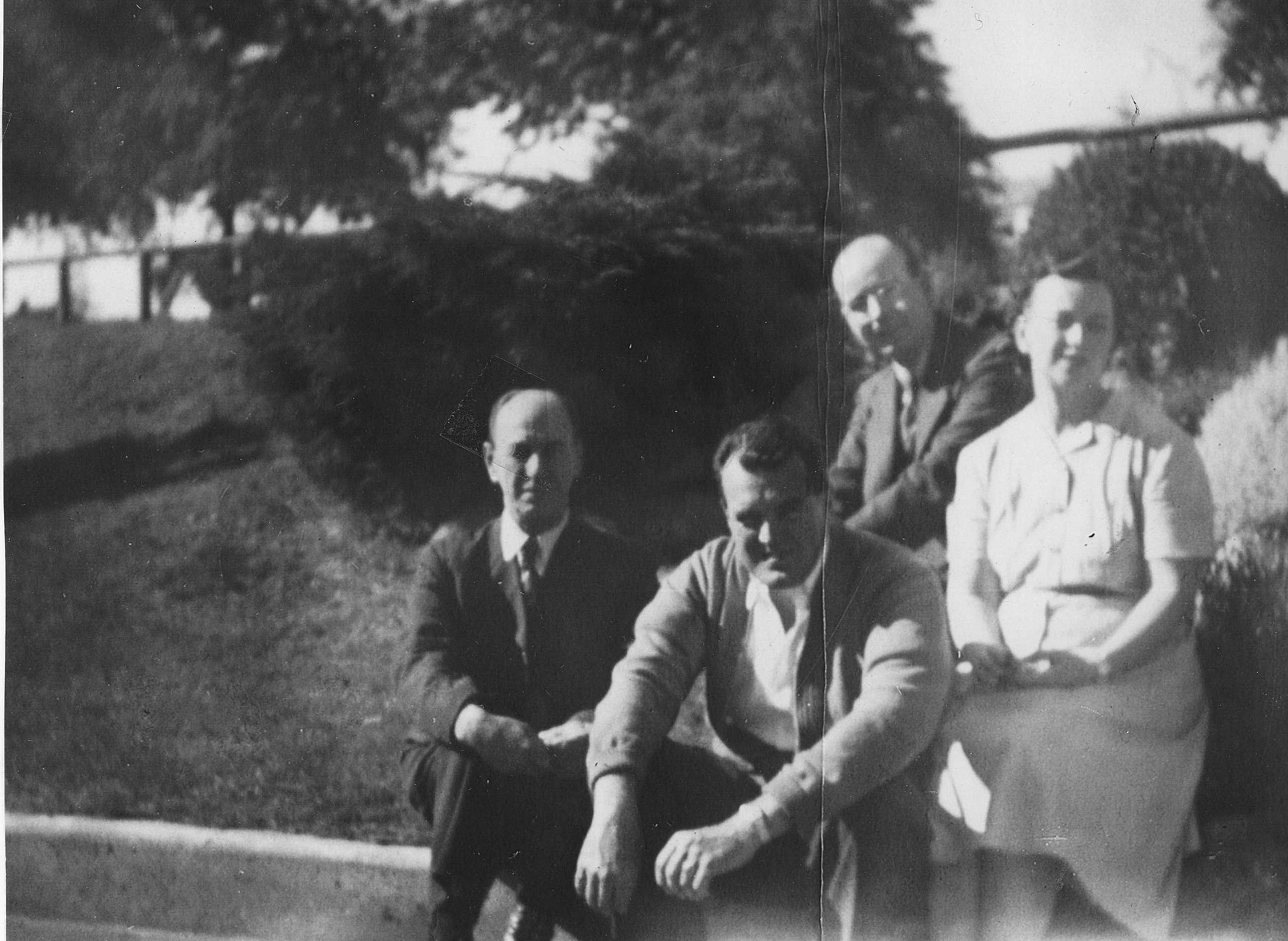 |
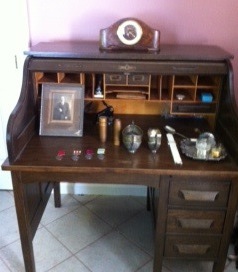 |
| Group picture in the 60s?: Harry, James, John, and Ella. |
Harry's desk with some Wighton treasures visible |
|
Harry's favourite story A young Scottish lad and lass were sitting on a low stone wall, holding hands, gazing out over the loch. For several minutes they sat silently. Then finally the girl looked at the boy and said, A penny for your thoughts, Angus. Well, uh, I was thinkin'... perhaps it's aboot time for a wee kiss. The girl blushed, then leaned over and kissed him lightly on the cheek. Then he blushed. The two turned once again to gaze out over the loch. Minutes passed and the girl spoke again. Another penny for your thoughts, Angus. Well, uh, I was thinkin' perhaps it's aboot time for a wee cuddle. The girl blushed, then leaned over and cuddled him for a few seconds. Then he blushed. Then the two turned once again to gaze out over the loch. After a while, she again said, Another penny for your thoughts, Angus. Well, uh, I was thinkin' perhaps it's aboot time you let me put my hand on your leg. The girl blushed, then took his hand and put it on her knee. Then he blushed. The two turned once again to gaze out over the loch before the girl spoke again. Another penny for your thoughts, Angus. The young man glanced down with a furled brow. Well, noo, he said, my thoughts are a wee bit more serious this time. Really? said the lass nervously in a whisper. Aye, said the lad, nodding. The girl looked away in shyness, began to blush, and bit her lip in anticipation of what might come next. Then he said, Dae ye nae think it's aboot time ye paid me the first three pennies?
I, Harry Latta Wighton, through the signature below, do certify that this was, indeed, my favorite story. |
|
 |
|
|
I, Miriam Eileen Wighton, through the signature below, do certify that Irish jokes are better. |
|
 |
|
|
Sources War-time Classification Certificate for Harry Wighton by the British military Extract of an Entry in a Register of Births kept at the General Registry Office, Edinburgh: Harry Latta Wighton Harry's Salary Journal, Work Site Journal, passport, and other papers and photographs A letter from the Canadian Pacific Ocean Services Ltd., dated August 27, 1917, that confirmed for whomever was reading the letter, the dates that Harry and his family travelled to Scotland and the ship they were on. Presumably, this was needed to document their arrival from Canada to Scotland for some reason. Marriage Certificate for Harry Latta Wighton and Miriam Eileen Jackson, December 23, 1911. Personal recollections of Marilynne Finlayson (neé Peterson), Dianne Harding (neé Wighton), David Wighton, and Mary Maxwell (neé Wighton) - all generation 9 Serzans, Margaret (generation 9) Various websites, including: A History of the Scottish People. by W. W. Knox. Chapter 1: The Scottish Educational System, 1840-1940. http://www.scran.ac.uk/scotland/pdf/SP2_1Education.pdf A History of the Scottish People. by W. W. Knox. Chapter 10: Summary of Economy and Society in Scotland, 1840-1940. http://www.scran.ac.uk/scotland/pdf/SP2_10Economy.pdf British Columbia Death Index, 1872-1979: part of Ancestry.com, as referenced by Margaret Serzans Leslie's Perth Directory, 1887 published by D. Leslie and costing 3 shillings. (http://deriv.nls.uk/dcn23/8569/85698399.23.pdf) John Wighton's entry in the general directory is at page 192 of that directory, page 214 of the pdf file. Priory Place can be found in the Craigie portion of the directory at page 280 (#302 of the pdf file). Library and Archives Canada: http://www.collectionscanada.gc.ca/databases/passenger/index-e.html. Select SEARCH: Then, enter the name of the ship (Corinthian), year of arrival (1907), and port (Montreal). The list you want is May, 1907. Harry is on page 8 of the document. Second class passengers to Canada are listed from page 2-8. Mountain View Cemetery Index: http://search.ancestry.ca/search/db.aspx?dbid=70665 Royal British Columbia Museum: Genealogical Services: http://search-collections.royalbcmuseum.bc.ca/Genealogy/basicSearch St. Johnstone F.C. website: http://www.perthstjohnstonefc.co.uk/history.php UK Incoming Passenger Lists, 1878-1960, Glasgow, Scotland, 1915, Pretorian. Data provided through Margaret Serzans, Ancestry.com http://search.ancestry.com/search/db.aspx?dbid=1518 Various letters from Ella Peterson (Wighton) to her brother John Latta Wighton Wikipedia: Firth of Forth Bridge: http://en.wikipedia.org/wiki/Forth_Bridge Wikipedia: History of Scotland: http://en.wikipedia.org/wiki/History_of_Scotland Where to now? To read more about Generation 7, Harry Latta Wighton's immediate family, just click top to make a selection from Generation 7's genealogical table at the top of this page. The navigation buttons just below will give you quick access to biographies in other generations. |
|
| Home page Meigle Wightons | Generation #1 (John) | Generation #2 (William) | Generation #3 (Thomas) | Generation #4 (John) | Generation #5 (John Baxter) |
| Generation #6 (John Murray) | Generation #7 (Harry Latta) | Under construction: Gen#8 | Under construction: Gen#9 | Under construction: Gen#10 | Under construction: Gen#11 |
| Index of the members of the Meigle Wightons | Index of the Essays in the Meigle Wightons website | Return to the Wighton Family Genealogy home page | |||